Here are some photographs of Glenelg and Somerton circa 1948 I’ve found along the way, that I thought some of you might like.
Glenelg Pier
On a post on his travel blog, John Pedler included three nice images of Glenelg Pier, all courtesy of Holdfast Bay History Centre photographic collection. The first two were taken in 1935 and 1936 respectively, and show the jetty aquarium:
The third image shows the pier after it was destroyed by a storm in April 1948: it was rebuilt (a little shorter) in 1969.
The Crippled Children’s Home
The State Library of South Australia holds many images of old postcards and photographs: one series was taken at the Crippled Children’s Home in 1948. The first image shows the building itself:
The second image shows some children on the beach, which must surely be Somerton Beach, right?
By way of comparison, the image from the Unredacted article looks like this:
Rubaiyats A-Plenty
If you haven’t already picked up on this, the irrepressible Barry Traish (surely the Duracell bunny of Somerton Man researchers) has recently done some digging on George Marshall’s Rubaiyat, and is now certain that it was not a false imprint. So here’s a nice collection of Rubaiyats from the post outlining his findings:
Other Images
This image of Chapman’s delicatessen in the 1940s is on sale on eBay, feel free to buy it if you like. I doubt they sold pasties, but who can tell?
Here’s a double decker bus of the era (I believe), courtesy of the Advertiser’s Adelaide Now site:
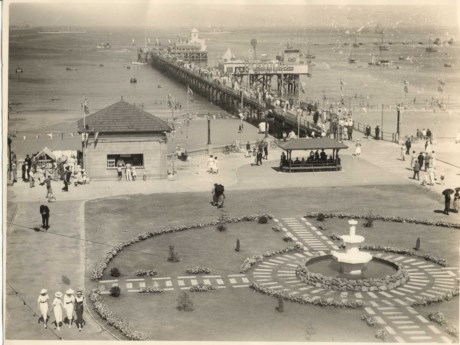
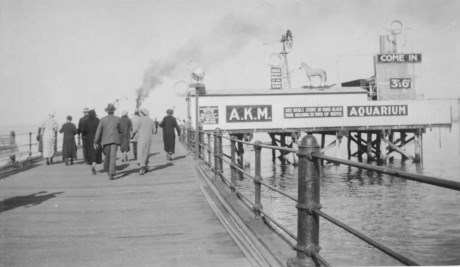
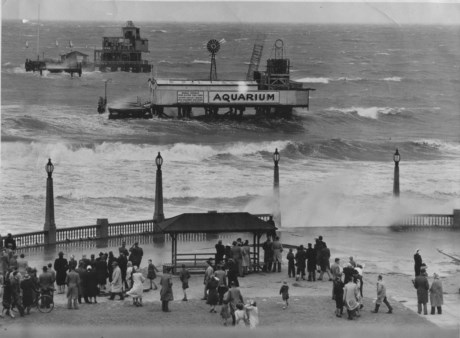
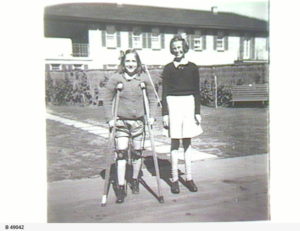
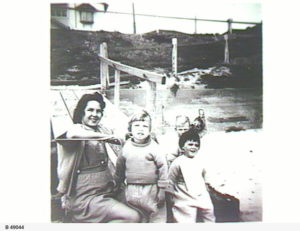

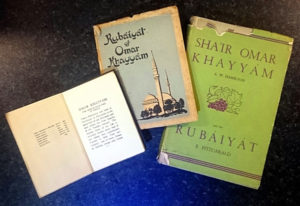
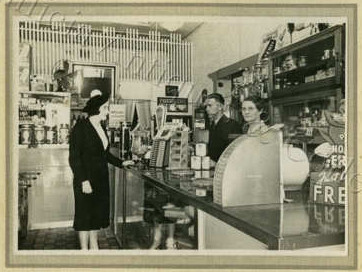
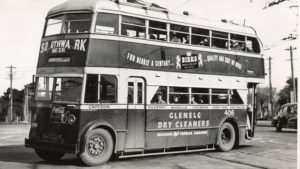
Nick,
I’m curious about your saying “I doubt they sold pasties…” Could you explain the reasons for that doubt?
It’s before I was born, of course, but ‘pies, pasties and sausage rolls’ were standard workman’s fare, and standard for the school tuck-shop from the late fifties, at least. Our local and very traditional Aus/English bakery always had them until recently when the owner finally retired. The new style is focaccia and vegan wraps, as you’d expect 🙂
The reason the pastie was mentioned was because the Somerton Man was believed to have eaten a pastie before his death. That is according to the autopsy results.
Diane: it’s because (a) I couldn’t see anything like pasties in the photograph, and (b) I would have expected pasties to have been sold in a bakery rather than in a delicatessen.
Nick – thanks for taking the time to explain. I see your point.
Nick
I’ve come across the following, and provide the link in case you’ve not heard of this author before. His article is about Adelaide but details accord with my own memory of Melbourne and of Sydney before the 1980s. The link also gives details of books on this subject by the same author. Might include some useful practical information.
http://www.adelaidenow.com.au/news/south-australia/how-we-spent-sundays-in-the-1950s-and-60s-and-70s/news-story/79a0b9c2cd7959237d4c06b049a15974
D: Allow me to set you straight on the pasty (ie) issue if I may. The pastie started life as a cold fare Cornwellian miners convenient morsell that their plump comely wives packed for them to consume during a crib break in the mine pits; much akin to the traditional British farmhand’s cold pork pie so esteemed in the Hartford Hereford and Hamshire, or even Sussex rural areas. For all of that the Australian Cornishmen with names like Kitto from the Burra copper fields would, I’m reliably informed, would not have been unfamiliar with a lunchtime cold pasty or three. Of course they were also sold in Adelaide delis and bakeries such as Wenzells of Glenelg (2) and one could take them at room temp. or from the pie warmer according to preference. Let it be known however that SM’s last meal being a pasty is pure SPECULATION based solely on potato having been found in his gullet. Being a confessed pasty conesseur from way back, I would have expected other odds and ends such as carrots, peas turnip and apple to show up also, had it been a proper Cornish pasty; though I’ll allow that I’m certainly not an expert on human digestion patterns. At the end of the day D. all I can really say is that anyone who may tell you otherwise could not possibly be a pastie (y) fan like the rest of us pheasant pluckers sons.
John,
I do know the Cornish ‘vegetable pie’. What I don’t know is where pasties could be bought hot in 1948. In a bakery, of course, as Nick says. Then again, the shops shut by 5.00 or 5.30 and pubs by 6pm (did pubs sell them?). In 1948 travellers were better catered for: kiosks and tea-rooms in many railway stations – what time did they close? Was the Travellers Aid society active in Adelaide as it was, say, in Melbourne… and what time did they close? As I recall, pasties were eaten only as a lunch-time snack/meal and ‘fast food’ tended to be eaten as a meal only in the form of the Friday night treat of fish-and-chips though I have that from hearsay; such things were never permitted in our house.
I take Nick’s point about delicatessens, though, because as I recall from the early 60s, our local deli sold only ‘dry goods’ such as biscuits (loose, from large tins) and preserved food: cured meats, cheese, salted butter, pickles and preserved vegetables etc.
The point really is that if SM ate his potato-containing food hot, there were few places he could have bought it in 1948, in Adelaide, after 5 pm.
D. Whilst Milongal and I have covered your query at some length in the recent past, most likeky on this very threadline, all you really need to know is that pie carts in Adelaide were numerous in the good old days and operated at all hours. Several were operated by hotels such as my own favourute, the grand old ‘Duke of York’, pics of which you can see on line; a horse drawn cart trapsing around the inner city streets purveying its fare of hot pies and pasties. If one were to inquire, there might well have been something wet on offer beneath the drop board o slake a keen thirst. Delicatessens of yesteryear carried all sorts of smallgoods like preserved saugage, olives, continental cheeses and sweetmeats. it would be quite unconcionable for such an establishnent not to include a few head of humble English pork pies and its close relative, the ubiquitous Cornish pasty (ie) in its inventory.
D: As we’re well aware ghibelline crenellations are just another word for swallow tailed loupes formed as fire slits in embattlement merlons; whereas my rosette merlons merely reflect on my ignorance of archetectural forms. I’m thinking that the specific design referred to, might have been more useful as an aid to the cocking and aim steadying features of advanced crossbow design…..SM also carried honed point scissors and a utility knife that might conceivably have been useful in equine maintainance I suspect.
(In SA at least) it’s a Jetty not a Pier (although I notice older references seem to say ‘Pier’ – and we certainly have pubs named ‘Pier’ (eg the Largs Pier which claims Jimmy Barnes among it’s favourite sons)
Also in SA lingo a ‘Deli’ is sort of what the Eastern State’s (or at least Victoria) would call a ‘Milk Bar’. In my lifetime (which doesn’t go back anywhere near 1948) they would certainly have sold Pies, Pasties and Sausage Rolls.
SA seems has several notable large scale Pie-makers – (off the top of my head) Cowley’s, Gibb’s, Balfours and Vilis (I have a feeling I’ve missed a major player) . I’m almost certain Vilmos (of Vili’s fame) was born in the 40’s so that brand at least is more recent – but the others I’m pretty sure would have existed back then. As JS points out, ‘Pie Carts’ were a big thing, and I think all the players above had them (until recently there were at least 2 in the city centre at night, and another one up the Parade in Norwood).
I assume the pasty came to Australia via the Cornish – who I think largely settled in the Copper Triangle (Wallaroo, Kadina, Moonta) – and certainly the best Cornish Pasties in SA come from that region (the original Price’s Bakery (only loosely connected to the Price’s drive-thru bakeries now in Adelaide Metro, I think)).
Anyway, I think it’s possible such a small shop would have sold snacks (including Pasties) – however I can’t see any pie-warmer in the picture (these days they often have ones with glass on the counter, but I remember old silver drawers usually sitting on a bench at the back). Of course, just because I can’t see it, doesn’t mean it’s not there – and it may well be in the back room (or in those times they may have had different pie warmers).
Someone (possibly you, JS?) at one stage suggested the ‘possibly a pasty’ in his gut could have been minestrone soup or similar – and without treading too far down paths I don’t want to go, I’ve sort of assumed the ‘pasty’ reference suggested the potato was in little cubes (which I think would also be consistent with a minestrone). There’s nothing really to indicate that it was a shop-bought meal either. I am no biologist (or chemist or any useful sort of scientist), but I would imagine pastry and potato break down in the gut at similar rates. Without knowing exactly what was in his gut (we’re sort of making some big assumptions off the scarce detail we have) we can’t be certain, but does it seem odd to have potato with no trace of pastry? That said, it seems odd too that the officials would decide ‘something like a pasty’ if all they saw was potato….
Oh also, the kids at the beach picture is interesting – because it appears there’s a ramp behind them rather than the stairs
Milongal: Check out the X pic on this thread,then check the same one out on the Taman Shud Unredacted site which is so much clearer. Forget about Const. Moss’ busy busted stairs and look further over to the left above the first sand mound just to the left of X. Above that you will note how there is less vegetation on the rough embankment and it appears that there may be one or two fence rails missing so as to enable folks to make an alternative track down to the beach. Now if you look ever so carefully above the wall right about there, you just might make out what to me appears to be evidence of recent disturbance similar to heel drag marks. I really don’t get the deal with the small sand mound on the beach at all, though perhaps it was just a convenient place to bury SM’s hat, teeth etc. not to worry. You might also look directly across the road and note that part of the Alvington high wall appears to have been breached. There is nothing to indicate the street lighting that Olive spoke about and in any case 7.45pm that time of the year, would still be daylight. Nice shore breeze blowing and at least another 45 minutes before the mozzies might decide whether to make their presence known.
Couple of days ago I posted about the unsuitability of Barbour thread for mending SM’s cloths and I’m pleased to see that TxT has now jumped on it to re emphasise my point. Followers may not be aware that a clever young soldier, who in the war, worked with Australian Intelligence as a German translater, initially at no. 4 camp Tatura and later at Rabaul during the war crimes trials. In 1951 he was recruited for service with ASIO and became director in the early 70s only to be sacked in 75 two weeks prior to the fall of government. A very talented fellow, keen on repartee and practical jokes who also loved a bit of salsa with his crumpet. We might then wonder did he also have a rather novel way of ensuring that folks would better remember him after introductions eg. a unique calling card. His name of course, Peter Robert BARBOUR and he ended up as Ambasador to Venezuala.
@JS: IT’s certainly possible that there’s some disturbances in the large dune – but it’s really hard to tell in those photos what dark spots are – shadow, weeds, something else? As an example (I’m not suggesting it’s interesting in terms of SM, just using it as an example), in the bottom right there seems to be a dark semi-circle – which you’d sort of assume is a drain, but I thought storm water is discharged through MUCH bigger pipes – and you’d expect the sand to be eroded to the bottom of it….
If that’s beach sand (which I assume it is) then any drag marks wouldn’t last very long before being destroyed through natural erosion and (if people were regularly traversing that section) by foot traffic.
The small mounds could indicate something’s been buried, or they could simply be where sand gathers as the wind whips it across the shore – or where water has washed sand down the hill given that they line up with the path missing vegetation. For me, the age of the photo makes it difficult to conclusively discern too much – and I don’t know we even know at what point it was taken. Given SM was originally just another mundane death the photo likely wasn’t taken until the mystery became interesting (from a media perspective) – which could have been weeks later….
NB: I find it interesting that Pebo is running with your Barbour Thread observations…but good that he is. Maybe I’ll have a read of it some time (I gave up on TxT a long time ago – partly because I found the commenting aggressive if you dared question or disagree, and partly I just found some of the posts a bit random and all over the place….
The two local Brighton & Hove Police Officers Moss and Shipway were called to attend another beach tragedy in June ’43. I have mentioned it before but will do so once again because it seemed most unusual to me when I first heard about it; still does. A Squadron Leader Bungey DFC had recently returned from England to join his English bride Sybil and their infant son Dick at the old family mansion at Somerton. Not long afterwards his wife died sudden and within a couple of weeks, Moss and Shipley were first on the scene of what appeared to be the officers own suicide and the attempted murder of his son by shooting. A holidaying farmer from Renmark had allerted the constables and assisted them to convey the badly wounded baby to Alvington Crippled Children’s Home for initial medical attention. Most fortuously he survived and even more so is still with us today, a man in his seventies who is very well known in Adelaide for his proud apholding of his war hero father’s legacy….My problem is the little fox terrier dog, ‘bomber’ who accompanied the pilot on his intended mission of self destruction that cold Somerton Beach evening. In my experience with suicides of such nature, where the killing of a loved one also seems warranted, the faithful dog is usually included in the pact; in fact the innocent creature’s sacrifice is most often a pre cursor to the main event. John Moss said that upon arrival on the beach, he found the little fellow staunchly on guard beside young Dick in his stroller and would not desist with his brave defence, only standing down after the dead hero was removed from the beach some time later. Am I seeing some possible weird connection between the unusual deaths of Sdn. Ldr. Bungey and our own dear SM five years later, at the same general location and with the very same officers attendant; surely not.
There’s a lot of oddities there….
– Constable Moss, although he knew the flier, didn’t recognise him because it was dark (and possibly because of the wound?)
– ABout halfway between Downing St and College Rd (About 1km South of SM) – So why take him to the Crippled Childrens home, which is beyond College Rd (would’ve been lots of other things in between (Surf Life Saving Club, Yacht Club etc)
– Gun was found nearby (as opposed to at the scene?)
Certainly an interesting coincidence at least
Milongal: You’re right of course; the photo with the disabled kiddies on Somerton beach have come by way of a down ramp and not my ‘broken’ stairway, reason being that the ramp would have been readily adapted for wheelchair use. Of course the stairway was not broken at all, more like purpose built so as to prevent the children from descending to the beach unassisted. It’d be interesting to know whether both means were concurrent in 1948; recently I read an account by a former patient from the fifties who recalls being assisted to the beach by means of attendant nurses carying him ‘piggy back’.
Peteb: Don’t know where you came up with the “small pastie” last supper recipe which although a new angle is not inconsistent with contemporary medical opinion. It would be my own view that the wee little maggot bag in your thread caption seems hardly worth dieing for but each to their own I guess…Back to the heart of the matter re quest for ‘what’s your poison’, I think I have a viable one that has potential to not only stop the heart insystol, to double up on the brain as well without leaving any hints for the pathologist. A good strong pressurised air bubble is the answer and depending on how introduced into the bloodstream, plain old oxygenated air can be made to duplicate the effects of many poisons with a bonus in controlled precision and no unsightly needle marks if administered carefully.
Asystole is the word for left ventrical heart valve stoppage from memory; though I recall that all contributing SM medical authorities will insist on ‘in systol’ with or without the ‘e’ which is dead wrong either way.
Here I am promoting the Ruffels scenario, in that our man was captured .. and nobody’s asked how come the hat who slipped away with the book knew the lady’s phone number.
Peteb: No big deal. everybody knew the bimbo’s phone number from ’47, even Prosper according to Adelaide small ads. Ruffles merely joined the Feltus band waggon with the Inner Sanctimonious crowd ie., Lawson, Cramer, Elliott, Four Fat Ladies anors.
Excellent response …. but why did he have it? The Ruffels plot has to have consistency.
The hat who slipped away was none other than off duty constsble John Moss and he left fearing he might have been made which I’m sure I alluded to previously. How could one dare to introduce such a grandiose proposition when it never crossed the minds of more enlightened folk like Ruffles.Feltus &Co. Truth is this case scenario way back though it obviously escaped notice amongst the punters or it would have been royally shit-canned. Well if one needs proof then go no further than the introductory passage of first inquest witness const. John Moss and you’ll immediately note a back hand admission by the cagey old plod of his off duty presence on the big night.
The Time of Death and the pasty have often struck me as inconsistent, however I seem to recall (I forget the source, as ever) that there was some question about the accuracy of the time of death. Secondly, at inquest Dwyer says:
“I would say that the food had been in the stomach for up to 3 or 4 hours before death. __It is difficult to given an opinion on that, because if the person is in a state of anxiety, that digestion might be suspended__ ”
So suppose death were a little earlier (let’s say midnight) and because of the man’s state digestion is “suspended” couldn’t we sort of make a case that he ate the pasty as early as 6PM?
There’s also this little bit: “There was a peculiar cellular reaction under the oesophigal mucosa, but I have not found an answer to that” – Sort of seems like it could be useful.
Milongal: Right again; there are so many variables concerning estimated time of death that neither the attending physician nor the pathologist were qualified to make one with any degree of certainty. For instance had the corpse been in a state of suspended animation through refrigeration or similar for a period prior to his s beach discovery, then all bets related to the partly digested pasty are off… period.
The SM man previously worked in a bakery in Victoria if we are to believe he is Charles Webb as per DNA testing. He obviously knew his way around a pasty. Did he work for a local bakery in SA under a fake name in the time that he can’t be accounted for between his disappearance from Victoria and his death in Adelaide? Did he commit suicide by poisoning his own pasty?